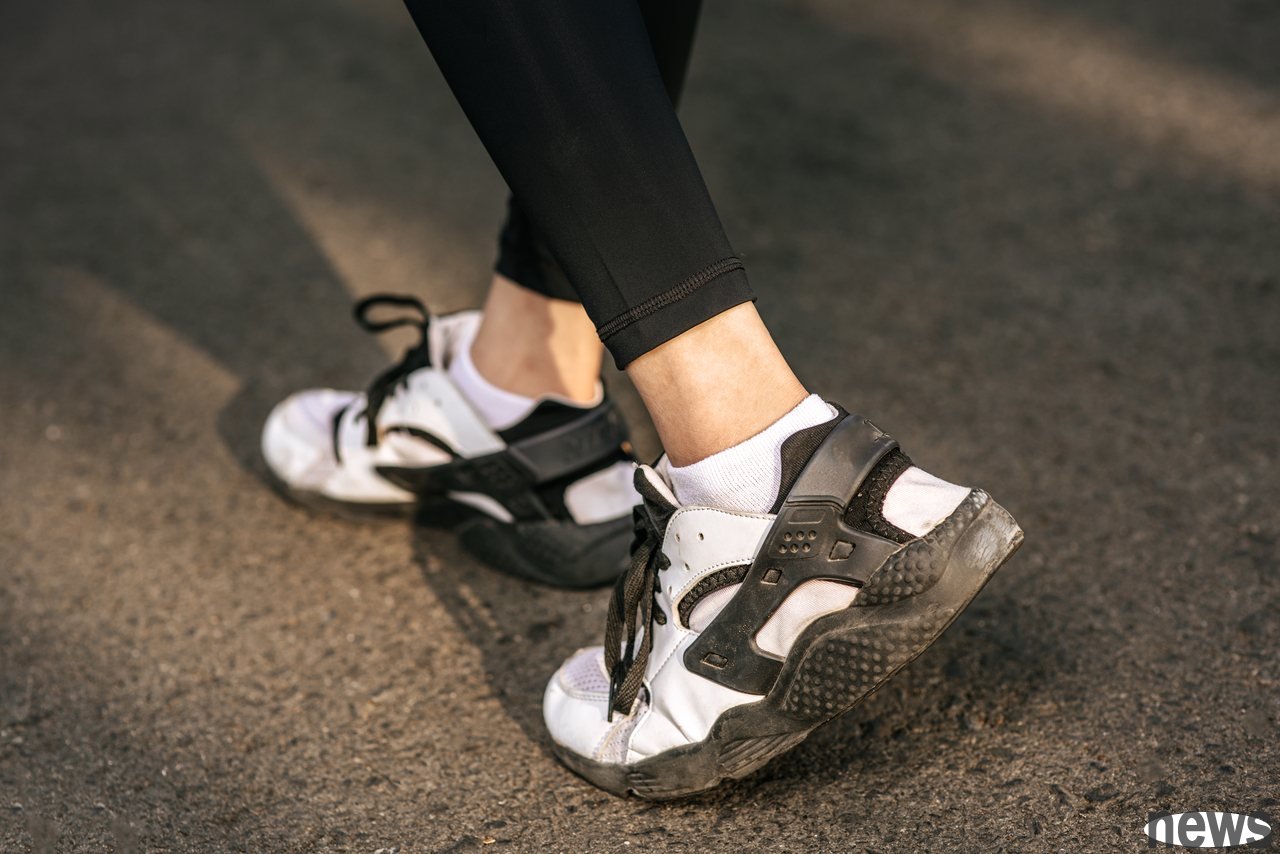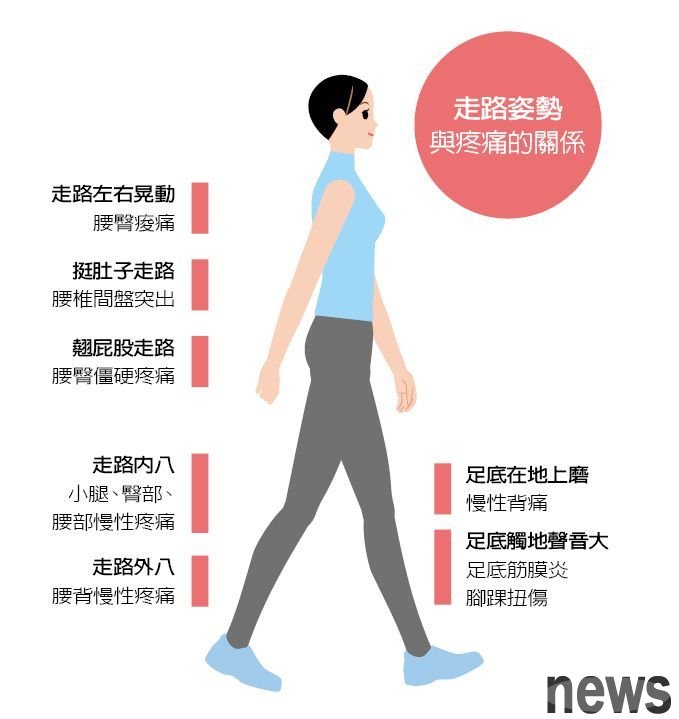
In the first midsummer of the epidemic, the people went abroad to travel "report" with their own travel, while others traveled on their own on their own touring saints and embarked on a dream trip. No matter what kind of journey it is, you have to rely on the "healthy feet" to take you far away. How to deal with double feet during the trip? To have healthy and powerful legs, correct walking posture and daily muscle training are indispensable.
Developing a correct walking posture can avoid fatigue and injury during long walking. Yu Chunren, a physical therapy physician at the National Yangming Communication University Affiliated Hospital, said that walking movements include raising your head and raising your chest, standing upright naturally, facing your toes forward, in the same direction as your knees, to avoid excessive inner or outer rotation of the tip of your feet. A good posture can avoid damage to your shoulders and waist when walking.
{9When walking, the foot touches the ground first, and then from the foot and rolls to the tip of the foot. The strength extends from the foot and the arch and the tip of the foot and the foot extending to the palm of the foot. The force is pushed forward from the big toe and the two toe. Correct and steady steps can improve walking efficiency; the legs are exerted and the legs are pushed forward. When walking, the buttocks are tightened and firm when they are properly moved, so that the core of the body can be stabilized, which can reduce the degree of physical fatigue; the arms of both hands and arms naturally move to improve walking efficiency.
He Chunsheng, director of the Rehabilitation Medicine Department of Luodong Boai Hospital, said that when walking correctly, you should use the core muscle group of the body (dospinal gluteus muscles) as the axial heart. Imagine a line from the head to the foot and lift the body gently, and move forward with the foot and touching the ground. Imagine walking on the ground in a similar way to move from foot to toe. In addition to the legs, the foot and toe will also exert force. When taking the step, the foot and the foot and then touch the ground first, and use the power of the thigh to drive the other foot forward. Do not drag it.

He Chunsheng analyzed common NG steps and possible diseases:
. Sole touching sounds: Commonly occur with plantar fasciitis or ankle twist.. Grinding the soles of the feet on the ground: chronic back pain is common.
. Swaying left and right, unstable body shape: causing pain in the waist and hips.
. Walking with a bulge of the stomach: In the future, it may cause a protrusion of the lumbar plate.
. Walking on the butt: mainly caused by the anterior pelvic pelvic dysfunction, and the common clinical condition is stiffness and pain in waist and hips.
. Extra-8: The tightness of the gluteus medius or the inconsistent angle of the femur anterior femoral lateral angle, causing chronic pain in the waist and back.
. Individual 8: The gluteus medius is weak or the femoral anterior angle is inconsistent, resulting in chronic pain in the calf, buttocks, and waist.
Xi Chunren said that poor walking posture is not only unelegant, but specific parts of the body have suffered too much pressure for a long time, and problems may occur in the ankles, knees, pelvis, lumbar spine, etc. The weight of the knee when walking is about 1 to 2 times the weight. If the walking posture is incorrect, it can easily accelerate the wear and deterioration of the knee joints. In severe cases, physical treatment or surgery may be required.
With the soles of the shoe, you can see if there is any problem with your walking posture and correct it as soon as possible.From the condition of the soles of the shoe, you can see whether the walking posture is correct. Chunren of Zi said that normal sole wear is equal in front and back sides of the double foot, which means that the soles of the foot are subjected to an even pressure. If there are the following situations, there is a problem with the walking posture.
. Inner side wear of soles: It may be flat feet, eight steps inside, and the sole pressure is concentrated on the heel and inside the foot. The knee joint force changes easily cause wear, causing knee joint pain and accelerated link deterioration.. Skin of the sole: It is nothing more than a high arch and eight steps outside. The sole pressure is concentrated on the heel and the outer side of the foot, which causes the ankle joint to be easily twisted, and may also cause soft bone wear on the knee joint, change in the joint pressure, and cause pain.
. The wear and tear of the two feet is not consistent: The wear and tear area is not uniform. If the wear area is not consistent, it means that the body may have a skew. Common reasons include long and short feet, imbalance in the center of gravity, rotation or skew of the pelvis. It is recommended to further evaluate and check to avoid problems that cause back pain over time.
. The front end of the sole is worn: it is mostly due to habitual tiptoe walking, the fascia on the back of the calf (Achilles tendon is tight), which will extend severely to the waist, prone to back pain and stiff shoulders.
Pick a pair of good shoesFlat foot shoesFlat foot is because the arch of the foot is too low. In addition to the poor shock absorption effect, every step you take, the foot will collapse inside, causing problems such as inner foot pain and knee pain. Xu Chunren suggested using shoes with arches and heels on the inner side of the foot, or giving "support" shoe mats. When the foot develops internal rotation, it can provide good support and avoid excessive skewness of the foot.
High Foot Arch ShoesHigh Foot Arch is because the arch is too high and lacks the elasticity of shock absorption. The pressure falls on the heels and toes, which is easy to cause pain. Xu Chunren suggested using softer shoe or air cushion, that is, "shock-absorbing" shoe cushion, supporting the higher arch, and avoiding the impact of the sole reaction force uploaded to the knee joint and pelvis, causing damage. Since the styles of shoe mats and shoe tools on the market are diverse, Xu Chunren suggested to consult a physical therapist to further understand the health of the foot before making a choice.
Responsible editor: Gu Zihuan
